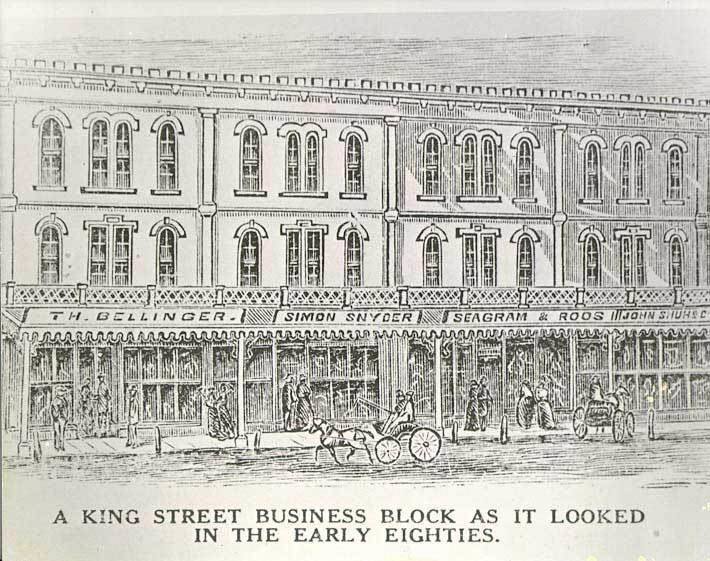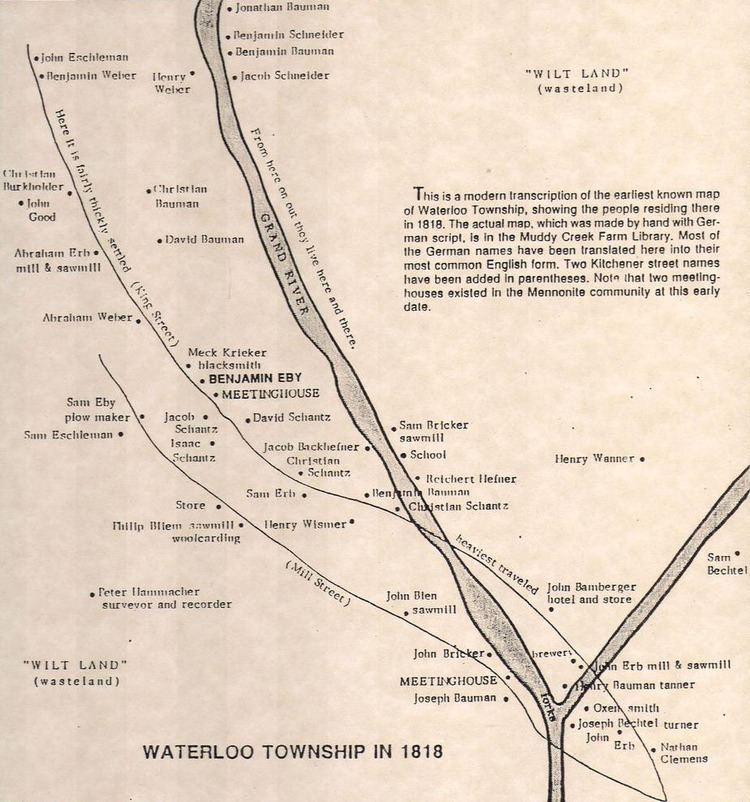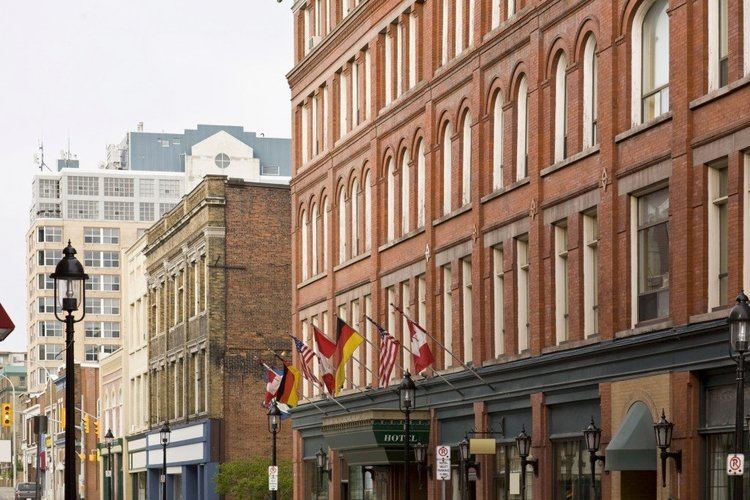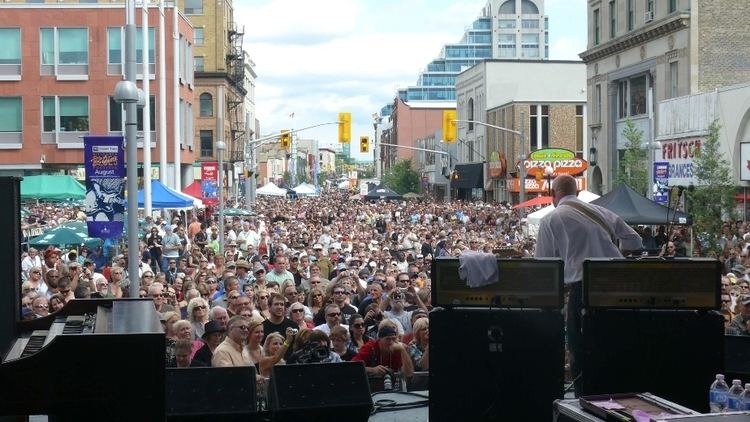Country Area 519 and 226 | Region Founded 1833 Mayor | |
Points of interest Doon Heritage Village, Joseph Schneider Haus, Chicopee Ski Club, Woodside National Historic Site, THEMUSEUM | ||
The City of Kitchener is a city in Southern Ontario, Canada. Located approximately 100 km west of Toronto, Kitchener is the seat of the Regional Municipality of Waterloo. It was the Town of Berlin from 1854 until 1912 and the City of Berlin from 1912 until 1916. The city had a population of 219,153 in the 2011 Census. The metropolitan area, which includes the neighbouring cities of Waterloo and Cambridge, has 507,096 people, making it the tenth largest Census Metropolitan Area (CMA) in Canada and the fourth largest CMA in Ontario. The city is adjacent to the smaller cities of Cambridge to the south, and Waterloo to the north. Kitchener and Waterloo are often referred to jointly as "Kitchener-Waterloo" (K-W), although they have separate municipal governments. Including Cambridge, the three cities are known as "the Tri-Cities".
Contents
- Map of Kitchener Ontario
- Cruising on king kitchener ontario 2013 part 2
- Cruising on king kitchener ontario 2013 part 3
- Geography and climate
- History
- Economy
- Culture
- Kitchener Blues Festival
- Kitchener Waterloo Multicultural Festival
- KOI Music Festival
- References
Map of Kitchener, Ontario
The City of Kitchener covers an area of 136.86 square kilometres.
Cruising on king kitchener ontario 2013 part 2
On 10 June 2012, the city of Kitchener celebrated 100 years of cityhood. Activities took place throughout 2012 in honour of this milestone.
Cruising on king kitchener ontario 2013 part 3
Geography and climate
Kitchener is located in Southwestern Ontario, in the Saint Lawrence Lowlands. This geological and climatic region has wet-climate soils and deciduous forests. Located in the Grand River Valley, the area is generally above 300m (1000) in elevation.
Kitchener is the largest city situated within the Grand River watershed, and the largest city on the Haldimand Tract. Just to the west of the city is Baden Hill, in Wilmot Township. This glacial kame remnant formation is the highest elevation for many miles around. The other dominant glacial feature is the Waterloo Moraine, which snakes its way through the region and holds a significant quantity of artesian wells, from which the city derives most of its drinking water. The settlements first name, Sandhills, is an accurate description of the higher points of the moraine.
History

In 1784, the land that Kitchener was built upon was an area given to the Six Nations by the British as a gift for their allegiance during the American Revolution; 240,000 hectares of land to be exact. From 1796 and 1798, the Six Nations sold 38,000 hectares of this land to a Loyalist by the name of Colonel Richard Beasley. The portion of land that Beasley had purchased was remote but it was of great interest to German Mennonite farming families from Pennsylvania. They wanted to live in an area that would allow them to practice their beliefs without persecution. Eventually, the Mennonites purchased all of Beasleys unsold land creating 160 farm tracts. By 1800, the first buildings were built, and over the next decade several families made the difficult trip north to what was then known as the Sand Hills. One of these Mennonite families, arriving in 1807, were the Schneiders, whose restored 1816 home (the oldest building in the city) is now a museum located in the heart of Kitchener. Other families whose names can still be found in local place names were the Bechtels, the Ebys, the Erbs, the Weavers (better known today as the Webers), the Cressmans and the Brubachers. In 1816 the Government of Upper Canada designated the settlement the Township of Waterloo.

Much of the land, made up of moraines and swampland interspersed with rivers and streams, was converted to farmland and roads. Wild pigeons, which once swarmed by the tens of thousands, were driven from the area. Apple trees were introduced to the region by John Eby in the 1830s, and several grist- and sawmills (most notably Joseph Schneiders 1816 sawmill, John and Abraham Erbs grist- and sawmills and Ebys cider mill) were erected throughout the area. Schneider built the towns first road, from his home to the corner of King Street and Queen Street (then known as Walper corner). $1000 was raised by the settlers to extend the road from Walper corner to Huether corner, where the Huether Brewery was built and the Huether Hotel now stands; a petition to the government for $100 to assist in completing the project was denied.
Immigration to the town increased considerably from 1816 until the 1870s, many of the newcomers being of German (particularly Lutheran, and Mennonite) extraction. Some were from Switzerland, like the founder of The Arthur Pequegnat Clock Company. In 1833 the town was renamed Berlin because of the recent German immigration from the Breuckmann family, and in 1853 Berlin became the County Seat of the newly created County of Waterloo, elevating it to the status of Village.
Economy
Kitchener’s economic heritage is rooted in manufacturing. Industrial artifacts are located in public places throughout the city as a celebration of its manufacturing history. While the local economy’s reliance on manufacturing has decreased in recent years, 20.36% of the labour force remains employed in the manufacturing sector.
Culture

Kitcheners cultural highlights include CAFKA, The Open Ears Festival, IMPACT theatre festival, the Multicultural Festival, the Kitchener Blues Festival and KidsPark, many of which are free to the public. Kitchener is also home to venues such as Homer Watson House & Gallery, Kitchener-Waterloo Art Gallery, THEMUSEUM, JM Drama Alumni and Centre In The Square. Also the Cities recently had two local and regional museums built in the region, one being the Waterloo Region Children Museum and the Doon Heritage Museum. Live music by popular artists can be heard at venues such as Centre In The Square and The Aud. The Kitchener Public Library is another community stalwart. Kitchener is also home to independent music label, Busted Flat Records which features the music of many Kitchener-Waterloo based musicians.
Kitchener Blues Festival

The Kitchener Blues Festival is a 4-day festival in downtown Kitchener dedicated to blues music, always held in August on the weekend following the civic holiday. The festival has expanded to 4 stages and 2 workshop stages throughout the downtown area, with over 90 performances. The festival has grown from a 1-day event with an attendance of 3,000 to a 4-day event with over 150,000 attending. In 2014 the Kitchener Blues Festival celebrated its 14th year.
Kitchener-Waterloo Multicultural Festival
This is a 2-day event in Victoria Park commencing usually on the first weekend of the summer. The festival features foods, dance and music from around the world. The festival also showcases several vendors that sell artifacts and crafts from around the world. This festival has been ongoing for well over 40 years. Well over 50,000 attend every year.
KOI Music Festival
KOI Music Festival is a 3-day festival held annually in downtown Kitchener each September. The festival was started in 2010 and has since expanded to include a free concert on Friday and a full day of performance Saturday and Sunday. KOI features 100+ rock bands every year, with a large focus on local, independent musicians. Notable past performers include Every Time I Die, Ubiquitous Synergy Seeker, Chiodos, Walk Off The Earth, Four Year Strong, Protest the Hero, Mad Caddies, Monster Truck (band), Gob (band), Treble Charger, Cute Is What We Aim For, The Planet Smashers, Bayside (band), and several hundred more.
